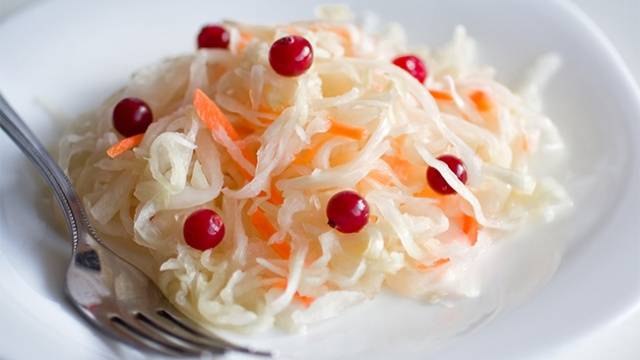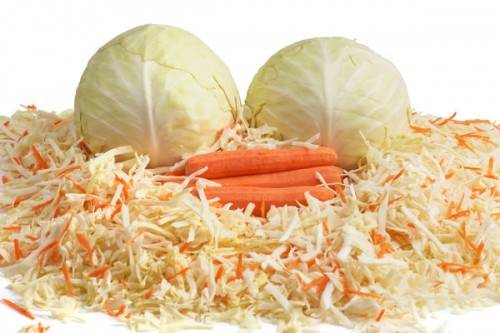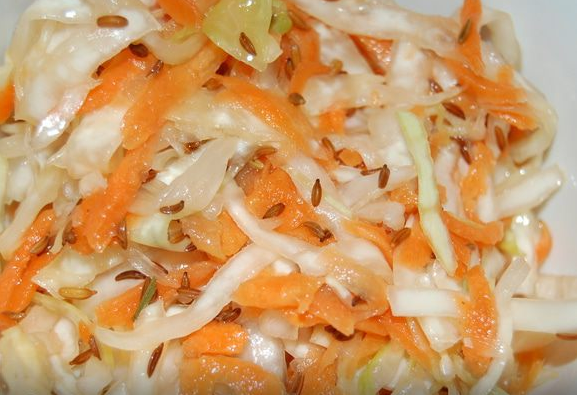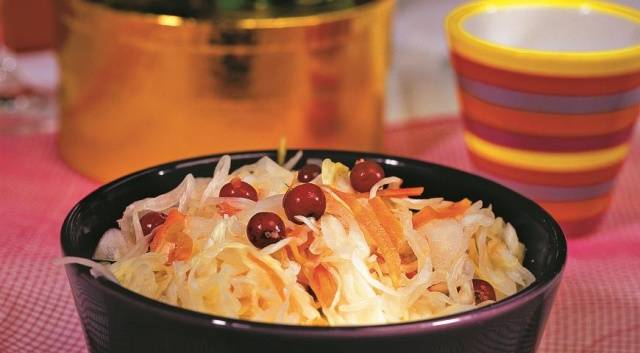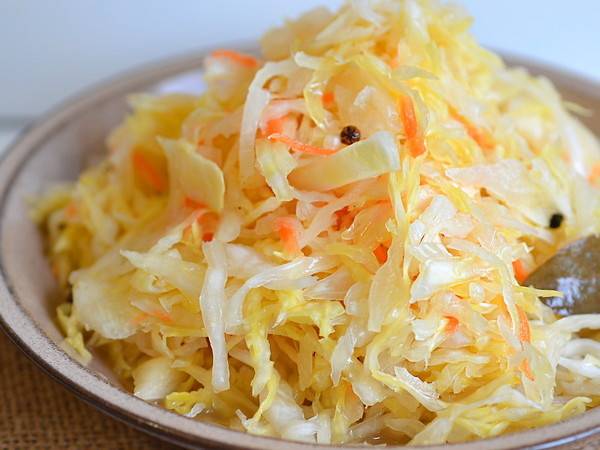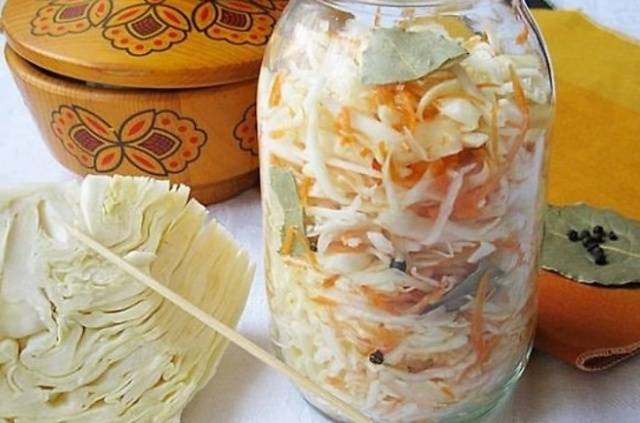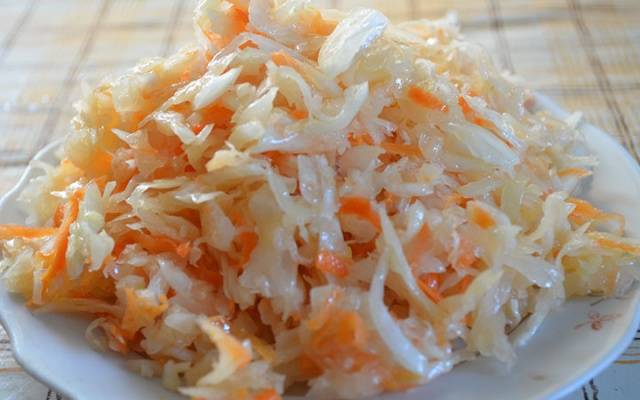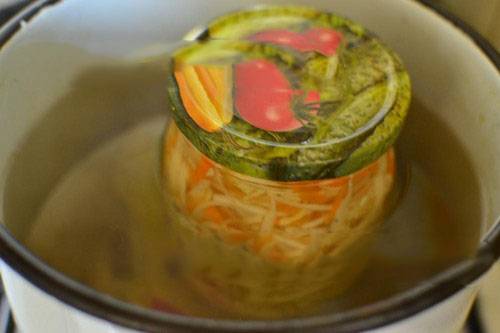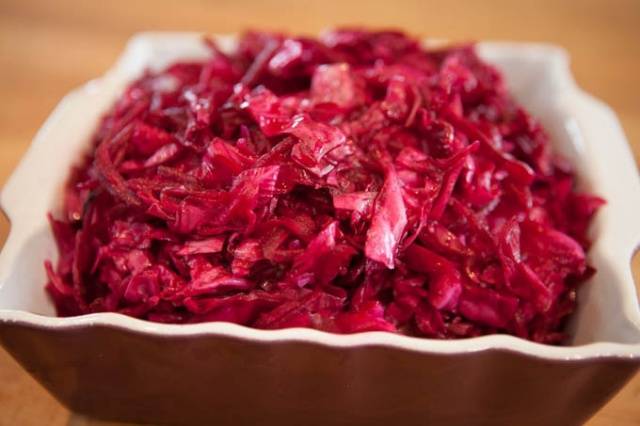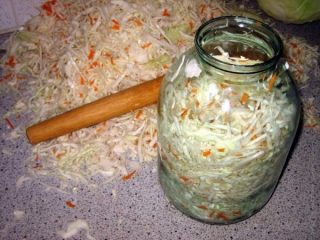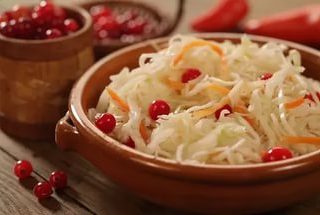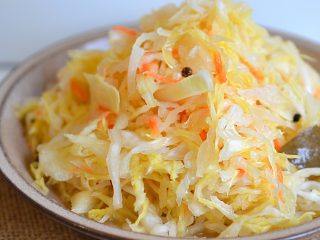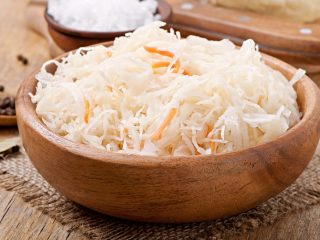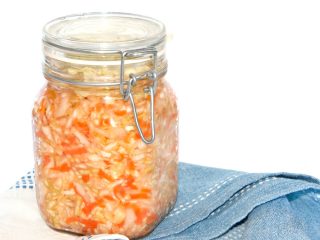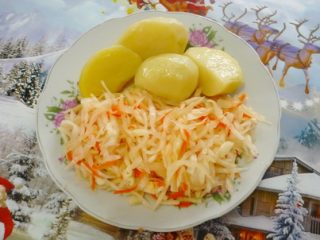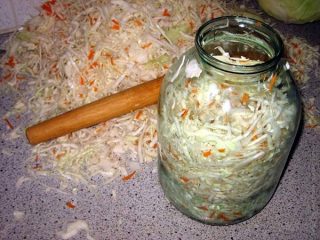Content
Sauerkraut is a treasure trove of vitamins. The vitamins A, C, and B contained in it increase human immunity, prevent tissue aging and the development of gastrointestinal diseases. In addition to vitamins, the fermented product contains a large number of fermented lactic bacteria, which activate the functioning of the gastrointestinal tract, saturate them with beneficial microorganisms and suppress harmful microflora. It is the lactic acid bacteria that make a tasty and healthy fermented product from fresh vegetables.
You can prepare fermented appetizer in several different ways. For example, in ancient times the Chinese fermented vegetables with the addition of white wine. Today, domestic housewives more often use classic recipes, but there are also “outlandish” ways of fermenting fresh cabbage with the addition of honey, apples, beets or garlic. We will try to describe the most interesting recipes and cooking secrets further in the section. After reviewing the proposed options, surely every housewife will be able to decide for herself how to ferment cabbage at home so that it is not only healthy, but also surprisingly tasty.
Secrets of successful cooking
When you decide to make sauerkraut, you definitely need to know some secrets.After all, sometimes failure to comply with even one seemingly insignificant nuance can lead to damage to a fresh product. So, quite often housewives get a slimy vegetable salad instead of crispy sauerkraut. In order to prevent such unpleasant surprises from occurring, the following rules must be observed:
- For pickling, you need to choose only late varieties of cabbage. The leaves of the vegetable should be as juicy as possible.
- It's better to shred cabbage in pieces, 5 mm thick. In this case, the vegetable pieces will remain crispy after fermentation.
- It is strictly forbidden to use iodized salt for sourdough.
- Fermentation of the product can be carried out in glass jars and enamel containers. It is impossible to ferment vegetables in aluminum buckets or pans, since this metal reacts with the acid released.
- Pickling cabbage at home should take place at a temperature of +20-+240C. Exceeding the temperature threshold can cause the cabbage to become slimy. Temperature below +200C will slow down the fermentation process.
- Ferment cabbage at home it will be successful only if during fermentation you periodically stir or pierce it with a knife or wooden stick. Lack of minimal ventilation will cause the product to become musty.
- It is necessary to ferment white vegetables under pressure. This rule is especially true in the case of dry fermentation.
- Sauerkraut must be stored at a temperature of 0-+20C. You can “find” such a temperature regime in the refrigerator or cellar. It is convenient to store the finished product in small glass jars.
Following these simple rules will allow you to prepare amazingly tasty sauerkraut and store it for a long time - up to 9 months. Sometimes during storage, mold begins to form on the surface of the fermented product. You can prevent its spread by sprinkling a small amount of sugar or mustard on top of the cabbage.
Classic recipe for dry fermentation
Many novice housewives do not know how to make traditional sauerkraut at home on their own. But the recipe for classic fermentation is very simple and does not require the presence of exotic products. So, for the starter you will need 4 kg of white vegetables, 400 g of sweet, fresh carrots and 80 g of sugar and salt. If desired, you can include cumin and cranberries in the recipe.
The cooking process is simple:
- The cabbage must be washed with water and freed from the top leaves.
- Chop it into small strips, 4-5 mm thick.
- Wash and peel the carrots, then grate them on a coarse grater.
- Salt the cabbage and rub it vigorously with your hands so that the vegetable produces juice.
- Add carrots and sugar to the main ingredient, as well as cumin and cranberries if desired. Mix all the ingredients again and place the fresh product into the starter container.
- It is necessary to place vegetables tightly in the starter container. Press down the kaputa with pressure and cover with clean gauze.
- For 3 days, you need to store the filled container at room temperature, stirring regularly or piercing the product with a knife. You need to remove the resulting foam 2 times a day.
- It is necessary to keep the winter preparation for another 4 days in a colder room, where the temperature fluctuates between +8-+100WITH.
- Place the finished product in small storage containers and place them in the refrigerator, cellar or on the balcony.
The above sauerkraut recipe Our ancestors also used it. They fermented it in huge 200 liter barrels in order to stock this useful product for a large family for the whole winter. Certainly, how to store sauerkraut at home in such a volume today it is not clear, so modern housewives prepare much smaller quantities of this snack and store it on the balcony or in the refrigerator. At the same time, cooking traditions are still preserved in many families from generation to generation.
Original pickling recipes
Today, if desired, you can find various recipes that give detailed recommendations on the implementation of one or another method of preparing sauerkraut for the winter. From all the variety of cooking options, it was decided to choose the best, proven methods of sourdough. You can find out more about them in the article:
Pickling in brine
The opposite of the dry fermentation method is pickling cabbage in brine. This method produces a very juicy and crispy snack, reducing the likelihood of mucus.
To prepare 3 liters of fermented product you will need 2 kg of fresh cabbage, 200 g of carrots, 50 g of salt and sugar, a bay leaf, a dozen black peppercorns and 1.5 liters of water. The cooking process consists of the following steps:
- Wash the vegetables thoroughly, chop the cabbage into thin strips, and chop the carrots on a coarse grater.
- Mix the vegetables and pack tightly into jars.
- Boil water, adding salt and sugar.
- Add additional bay leaves and peppercorns to the filled jars.
- Pour the prepared hot brine into the jars.
- Ferment the product at home for three days.
- Once a day, pierce it with a long knife.
- Place the fermented cabbage in smaller jars, cover and store in a cool place.
This method of fermentation is suitable even for inexperienced housewives. The recipe is easy to prepare and allows you to quickly and tasty ferment vegetables for the winter.
Recipe using honey
By adding honey you can get a particularly tender fermented snack. This ingredient replaces sugar and makes the product even healthier. The taste of honey can be preserved in cabbage throughout the winter period.
To prepare a winter preparation according to the proposed recipe, you will need 5 kg of cabbage, 90 g of salt, 75 ml of natural honey and 5-6 bay leaves. This non-standard set of products allows you to prepare a very tasty and healthy snack. The cooking process itself consists of the following steps:
- Remove the top leaves from the cabbage. Chop the heads of cabbage.
- Add salt to the chopped vegetable and grind thoroughly until it releases juice.
- Dissolve honey in water. The amount of liquid should be minimal. For 75 ml of honey, only 50-60 ml of water is enough.
- Add the honey solution to the main ingredient, then mix it.
- Place one bay leaf at the bottom of clean jars. Fill the containers with cabbage, compacting each new layer. It is better to not fill the jars completely, leaving a little space for cabbage juice to accumulate.
- Leave the cabbage in the house for 3 days, at a temperature of +20-+240C. Such conditions will allow fresh vegetables to ferment faster.
- Drain excess juice from the jars, leaving only a small amount (the juice should cover the top layer of vegetables).
- Cover the filled jars with iron lids and sterilize them in boiling water over low heat for 20 minutes.
- Roll up the sterilized jars, then turn them over and wrap them in a blanket.
A recipe for sauerkraut using sterilization allows you to store winter preparations in the pantry without taking up free space in the refrigerator. This feature is an important advantage of the recipe.
Spicy sauerkraut
Sauerkraut can be not only sour, but also quite spicy. There are many pickling recipes that include garlic or, for example, horseradish. We suggest housewives prepare very spicy sauerkraut with horseradish, garlic and beets. In order to truly appreciate this unique recipe, you must try the prepared snack at least once.
To prepare spicy cabbage for the winter, you will need 4 kg of cabbage, 400 g of beets, 2 heads of garlic, 30 g of horseradish (root), 60 g of sugar and 80 g of salt. The recipe is to use brine. To prepare it you will need 1 liter of water.
To understand how to properly ferment cabbage according to the proposed recipe, you need to familiarize yourself with the following recommendations:
- Peel and chop raw beets and horseradish root. To do this, you can use a regular large grater or a Korean carrot grater.
- Remove the garlic heads from the peel and chop with a knife or pass through a press.
- The cabbage must be finely chopped.
- Mix all the vegetables together. Place the workpiece in a container for ripening, compacting it thoroughly.
- Boil water, add sugar and salt to it.Fill the containers with cabbage with a hot solution and, if possible, place a weight (oppression) on top.
- Pierce the cabbage with a knife 2 times a day to remove gases formed during the fermentation process.
- If prepared correctly, the spicy snack will be ready only after 7 days.
The proposed recipe allows you to prepare a very tasty, savory snack with excellent color. A recipe with a photo allows you to appreciate the unusual and very appetizing appearance of such a product.
You can see an example of how quickly and competently an experienced housewife ferments cabbage at home in the video:
The proposed video will allow you to clearly appreciate the ease of preparation of this wonderful, tasty and healthy product.
Conclusion
Thus, the article suggests several different ways to prepare sauerkraut. Focusing on personal preferences and culinary abilities, the housewife must independently choose the best cooking option for herself. At the same time, it is important to follow the basic rules and secrets of ripening, which will allow you to prepare a tasty and natural product without spoiling the vegetables.
